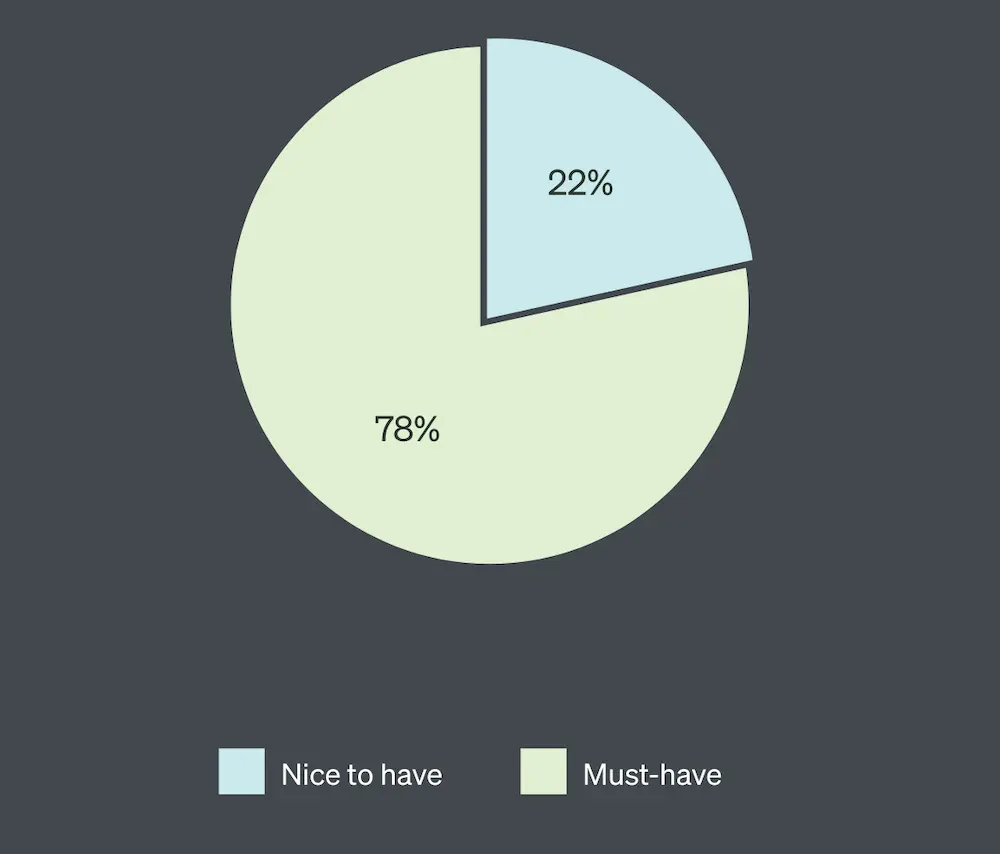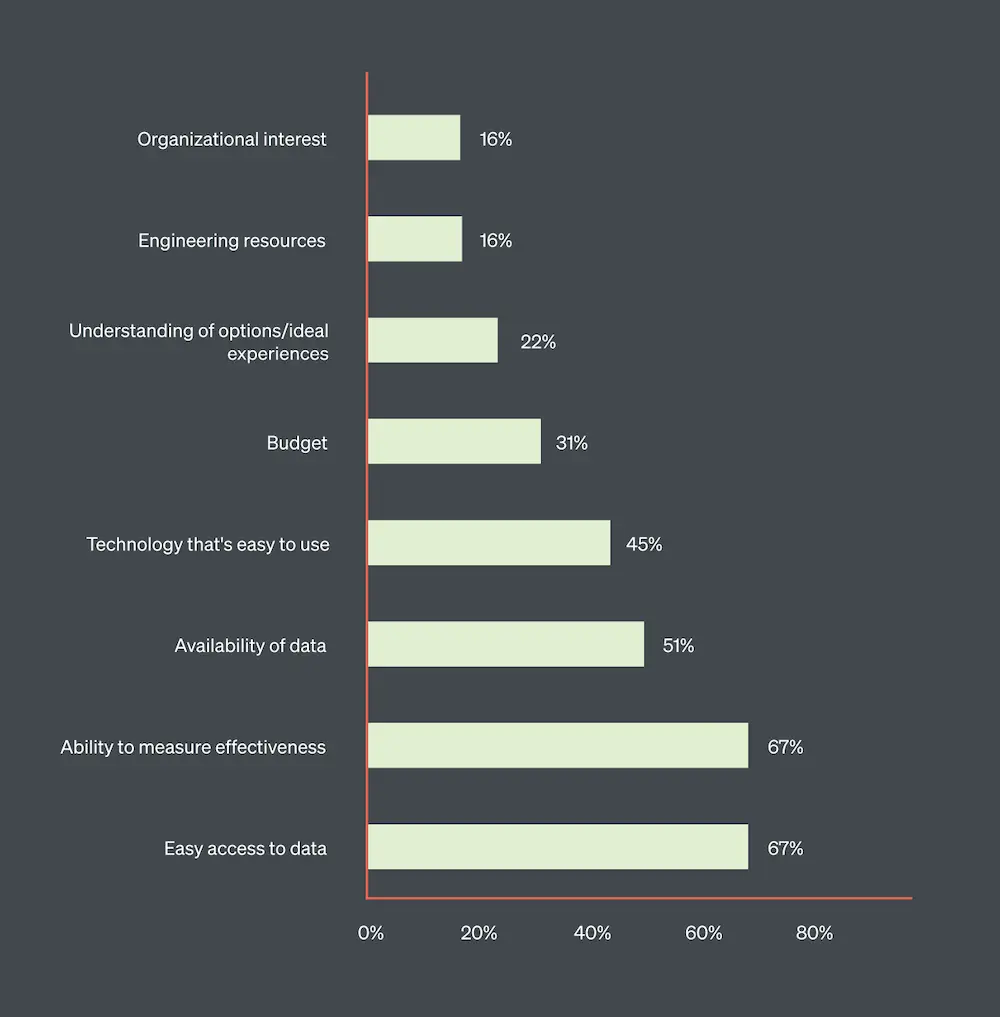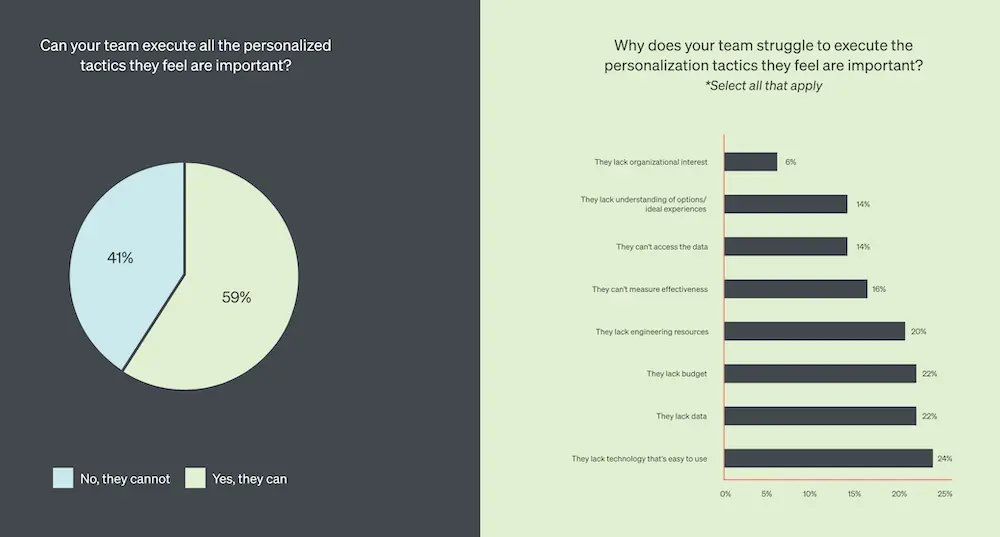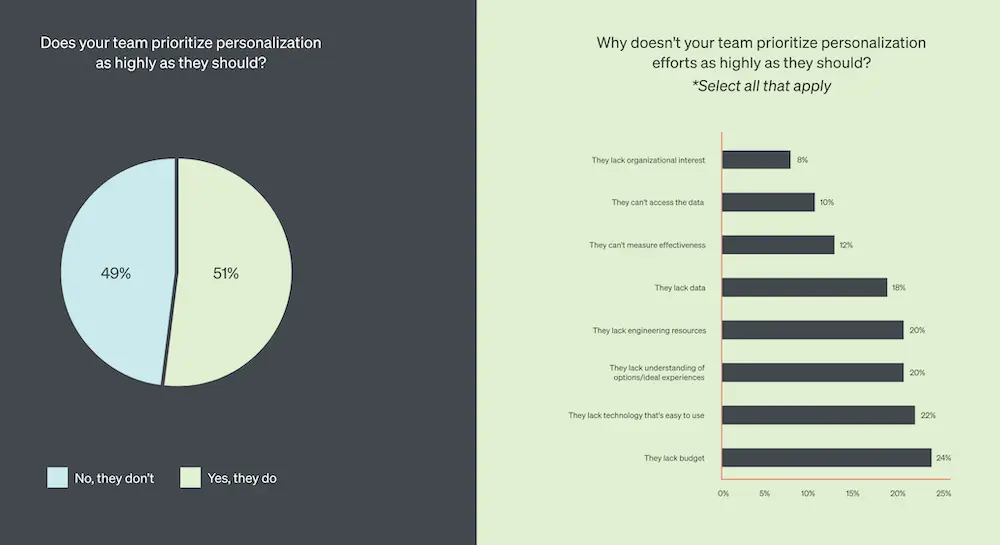Ecommerce execs reveal barriers to personalization at scale

Why do so many large brands still struggle to deliver personalized marketing at scale?
Although 78% of ecommerce executives believe personalization is a must-have in marketing, 41% say they cannot execute all the personalized marketing tactics they deem important, new research finds.
For years, marketers have been learning that consumers are more likely to shop with brands that recognize them, remember them, and provide them with relevant offers and recommendations. Companies that excel at personalization in marketing generate 40% more revenue from related activities than average players, according to McKinsey & Company—and while 71% of consumers expect personalization from the brands they interact with, even more (76%) get frustrated when they don’t get it.
Why, then, do so many large brands still struggle to deliver personalized marketing at scale?
In partnership with research firm BWG Strategy, Klaviyo surveyed 51 ecommerce executives for their input on personalized marketing—and learned that while personalization is a high priority for enterprise ecommerce businesses, there’s plenty standing in the way of achieving it.
Read on to learn why ecommerce professionals from the manager level to the C-suite believe personalization at scale is a competitive advantage for businesses like theirs—and what it would take for them to fully reap the benefits.
Survey methodology + demographics
BWG screened survey respondents through a number of questions in order to confirm their eligibility for the survey. All responses were anonymous and aggregated, and BWG treated respondent identities confidentially. In aggregate:
- 47% of survey respondents represent large organizations with more than 500 employees.
- 31% of the businesses represented generate more than $500M in annual revenue.
- The majority of respondents hold a director-level position in their organization.
- 75% of respondents cover marketing as their area of responsibility and expertise.
- 92% of respondents report that their business is currently growing.
What is personalization at scale?
Personalization at scale refers to the ability to deliver personalized experiences to a large number of individuals or groups, often using automated technology and data analysis. It involves tailoring content, recommendations, and interactions to each individual’s preferences, behavior, and context, in order to create a more engaging and relevant experience.
It’s a fancy-sounding phrase for a deceptively simple premise: creating different marketing experiences for different shoppers, based on each individual’s specific interests and needs, no matter how many consumers are in your prospect and customer base.
You might, for example, implement a sign-up form that only offers a chance to enter and win a free product to shoppers who haven’t yet made a purchase.
You might send a different abandoned cart text to different shoppers based on their cart value: a simple reminder for those whose total is under $100, and a discount code for bigger spenders.
Or you might send distinct post-purchase emails depending on the specific item someone purchased, containing a how-to video or a satisfaction survey soliciting product feedback.
The magic of marketing that’s personalized at scale is that even though you’re creating content that can serve many, the end customer experiences it as tailored and exclusive. Compared to mass-produced, generalized marketing campaigns, personalized marketing feels 1:1—without costing you the effort of maintaining a personal relationship with each and every customer.
“Done right,” McKinsey says, “personalization enhances customers’ lives and increases engagement and loyalty by delivering messages that are tuned to—and even anticipate—what customers really want.”
3 reasons personalization at scale is a must-have
No surprise, then, that most ecommerce executives believe personalized marketing is a must-have, according to our research.

Some of those who disagree believe “a product should sell itself,” as one manager/supervisor covering IT argues. But many of the 22% of survey respondents who consider personalization to be only “nice to have” still believe it can give businesses a leg up over the competition. “I don’t think it’s necessary for success,” explains one director covering ecommerce. “But it can aid in setting brands apart.”
In other words, as one company owner/co-owner covering marketing, communications, and customer relations puts it, “You can still be successful without personalized marketing, but you can be even more successful with it.”
You can still be successful without personalized marketing, but you can be even more successful with it.
Company owner/co-owner covering marketing, communications, and customer relations
Overall, the vast majority (88%) of survey respondents agree to some extent that personalization is a competitive advantage—and a major contributing factor to their company’s success.

Here are 3 key reasons why ecommerce executives identify personalized marketing at scale as a must-have.
1. Personalization at scale is your defense against increasingly fiercer competition
Consumers today are “overstimulated,” observes one individual contributor covering ecommerce—and not always by choice.
Advertisements and marketing messages are as ubiquitous as apps, games, and streaming services, and many of them are flashier and cleverer than ever before.
“Anyone and everyone is trying to sell you something, get your attention, and bombard you with information,” points out a director covering marketing, communications, and customer relations. “Unless it is targeted and relevant, you are likely not going to read it, let alone consume it.”
It’s kind of like that rule often attributed to business author Patrick Lencioni: If everything is important, nothing is. In an always-on world where consumers are “inundated with so many marketing messages,” says a manager/supervisor covering marketing, communications, and customer relations, “only the targeted, personalized messages that directly relate to a customer’s specific needs will cut through the noise.”
Only the targeted, personalized messages that directly relate to a customer’s specific needs will cut through the noise.
Manager/supervisor covering marketing, communications, and customer relations
Think of your own inbox. How many of the messages in your promotions tab do you open, let alone click on, and how many go straight to your trash bin—or, worse, sit there unseen and ignored until the day several years from now when your Gmail account is running low on storage space and you decide it’s time for a mass delete?
“Our company is not unique in our offerings per se. We need to find ways to differentiate ourselves, and I don’t believe it will be in our products and services but rather in our brand experience,” explains a VP covering marketing, communications, and customer relations. “Part of that experience is ensuring we are offering the right things to the right people at the right time, and tracking to ensure we help customers with their needs and journey.”
Another VP covering marketing, communications, and customer relations summarizes it simply: “Customers receive too much information. The more direct and relevant the information, the more valuable.”
2. Personalization is now a baseline consumer expectation
In order to build credibility with consumers, your marketing can’t just be the smartest or the sexiest or the most engaging, full stop. With so many marketing messages out there that check all those boxes, what your marketing efforts should aim to be, above any other adjective, is relevant—a word whose meaning may change drastically from individual to individual.
“Customers are getting smart about marketing tactics,” says one director covering marketing, communications, and customer relations—which is a polite way of saying their bullshit detectors are more sensitive than ever.
That’s largely attributable to the pandemic, which pushed many facets of everyday life online. In a post-2020 world, consumers expect digital experiences to mimic real life. They don’t want faceless interactions, and they don’t want to feel like they’re speaking with a robot—or, worse, being talked at by an algorithm.
What consumers want is to feel special—like they matter to your company as more than just their credit card number.
“Feeling VIP is making people buy,” confirms another director covering marketing, communications, and customer relations—and that means the reverse is also true. If consumers don’t feel like your company sees and appreciates them, they will not hesitate to take their business elsewhere.
“The buying process is getting more personalized on every major platform, and consumers now have this expectation wherever they shop,” points out another director covering marketing, communications, and customer relations.
In short: Everyone’s doing it. If you aren’t, you’re not even keeping up, let alone winning. “Audiences increasingly expect personalized marketing as more and more companies do it,” says one manager/supervisor covering marketing, communications, and customer relations. “It looks bad if you don’t.”
Audiences increasingly expect personalized marketing as more and more companies do it. It looks bad if you don’t.
Manager/supervisor covering marketing, communications, and customer relations
3. Personalization at scale boosts customer engagement—and ROI
It not only looks bad if you don’t personalize—it also, frankly, doesn’t work anymore. “Marketing messages that don’t personalize have a much lower engagement rate,” explains one VP covering marketing, communications, and customer relations. “They’re less effective.”
By measuring metrics like conversion, open, and click rate, unsubscribe and unfollow rate, customer return rate, order values and frequency over time, customer lifetime value, and more, many ecommerce executives have found that personalization at scale is a surefire way to not only stand out and meet rising consumer expectations, but also drive loyalty, retention, and repeat sales.
“By utilizing personalization via channels where we can personalize—email and SMS—we typically see higher rates of engagement, such as open rates and click-through rates, vs. when we don’t use any personalization,” explains one company owner/co-owner covering marketing, communications, and customer relations.
“We identify increasing engagement rates once we move customers from our general database to segmented lists,” agrees a manager/supervisor covering marketing, communications, and customer relations.
Plus, the more specific someone’s interest, “the higher the chance of a conversion,” adds a director covering marketing, communications, and customer relations. “Competitors that can provide an experience closer to a 1:1 of the customer’s interests or needs will reduce the amount of time to conversion and potentially increase brand trust. The faster you can meet a user’s needs, the faster they may become your customer.”
Competitors that can provide an experience closer to a 1:1 of the customer’s interests or needs will reduce the amount of time to conversion and potentially increase brand trust.
Director covering marketing, communications, and customer relations
All of this has serious implications for your bottom line. “Personalized marketing has been consistently shown to deliver higher ROI,” says a manager/supervisor covering ecommerce. “As data warehousing capabilities and in-house data management expertise continue to develop across many organizations, those who can deliver the most efficient marketing campaigns will be the ones to survive and grow.”
What it takes to scale personalized marketing
OK, you’re convinced—personalization at scale is a must-have for your ecommerce business. But what’s actually necessary to deliver a personalized marketing experience to your customers?
According to one VP who responded to our survey, the answer is “lots.”
In response to this question, common refrains from our research include sophisticated automation and segmentation capabilities, artificial intelligence, sufficient bandwidth and budget, creative resources and support, and cross-organizational communication and collaboration.
But by far, the single most important requirement for a personalized marketing strategy is data—clean, reliable data on customer information and behaviors, both real-time and historical, that you can integrate across platforms and use across departments.
“We need our systems to talk to each other, ideally in real time or near real time,” explains a VP covering marketing, communications, and customer relations.
The top requirements for marketing teams to successfully scale personalized marketing, according to our research, include:
- Easy access to data (identified by 67% of respondents)
- The ability to measure effectiveness (67%)
- Availability of data (51%)
- Technology that’s easy to use (45%)
- Budget (31%)

Compared to “streamlined data sources speaking to one another,” as one director covering marketing, communications, and customer relations explains it, understanding of ideal options/experiences (22%), engineering resources (16%), and organizational interest (16%) are less important for achieving personalization at scale.
Learn more about Klaviyo’s unified customer data platform
Top 3 barriers to personalization at scale for ecommerce businesses
Unfortunately, what businesses need to achieve personalization at scale—clean, reliable, actionable data—is often also what they lack.
According to our research, 4/10 ecommerce marketing teams cannot execute all the personalized marketing tactics they deem important, primarily because they lack technology that’s easy to use (24%), they don’t have the necessary data (22%), and they don’t have the budget (22%).

Meanwhile, 5/10 respondents report that their teams do not prioritize personalized marketing as highly as they should, primarily because they don’t have the budget (24%), they don’t have technology that’s easy to use (22%), they don’t know enough about their options (20%), and they lack engineering resources (20%).

Let’s explore a few of those top barriers to personalization at scale in greater depth.
1. The data you have isn’t capable of driving personalization at scale
While executives agree data is absolutely necessary for personalization at scale, almost half (47%) say they don’t have access to all the data they need to make it happen.

Nearly all survey respondents reported some limitations of data accessibility and usability. Predominantly, ecommerce marketing teams lack access to comprehensive data that’s necessary for effective personalized marketing at scale.
“We haven’t collected enough data on our end,” admits one VP covering marketing, communications, and customer relations. A manager/supervisor covering marketing, communications, and customer relations knows their team needs more third-party data, but says, “we’re struggling to find an ethical way to source it.”
More specifically, marketing teams are not able to gain access to data from their retail locations, and even the data that’s available does not often provide a complete picture of individual customer journeys.
“Through Google Analytics, we get a good amount of data on a visitor’s current web session,” explains one manager/supervisor covering marketing, communications, and customer relations. “But we have difficulty measuring the same person’s activity over time and connecting our different platforms.”
For some ecommerce marketing teams, rather than collecting enough data, “it’s more an issue with compiling the data in one area,” says one director covering marketing, communications, and customer relations. “Right now, it is ‘owned’ in several different areas.”
Many enterprises are bogged down by an overabundance of “dark data”—data that is unstructured and siloed and, therefore, not actionable. As another director covering marketing, communications, and customer relations explains, “our data comes from different streams at different intervals and involves different people and types of requests.”
Many enterprises are bogged down by an overabundance of “dark data”—data that is unstructured and siloed and, therefore, not actionable.
2. Your technology isn’t equipped to support personalization at scale
Collecting the right amount of the right data, after all, is only the tip of the iceberg. Getting it organized in such a way that you can understand it and act on it requires a well-integrated tech stack.
But according to our research, there’s a disconnect between the personalized marketing experiences brands want to create and the tools they have available in order to actually do so: nearly half (47%) of respondents report that their tech stack is only somewhat integrated.

“We use NetSuite as an enterprise system, but it does not fully integrate with our ecommerce stack like Shopify and other tools like advertising platforms,” explains a director covering marketing, communications, and customer relations. “We’re missing intent data that is integrated into our system,” agrees another.
One VP covering marketing, communications, and customer relations says what their team needs is not just “updated demo info,” but the domino effect of chain reactions that updated demo info is supposed to set in motion: “updated demo info that then speaks to our data warehouse and out to our two main systems which then powers our marketing automation.”
Many ecommerce executives need “more robust marketing platforms,” says a VP covering sales. One president/C-level executive covering ecommerce, for example, says the first missing tech piece for their team is a pop-up tool that enables them to add personalization features to their lead acquisition pop-ups, such as fields for gender, age, goals, and more.
Then, it comes back to integration. “This must then feed into our CRM so we can create automated personalized email and SMS sequences to go out to different subsets of users,” the president/C-level executive explains. “And then we need someone who knows how to use these tools effectively.”
Other respondents identify tech stack challenges with attribution, machine learning and decisioning engine capabilities, A/B testing, and more.
3. Budget constraints limit your ability to prioritize personalization at scale
One director covering marketing, communications, and customer relations cites “operating budgets and lean staffing” as their team’s primary barrier to personalization. Another blames “a limited budget that restricts our ability to invest more significantly into personalization opportunities.”
“We build personalized opportunities in many areas but do not yet have access to a ‘suite’ or offerings on a personalized level,” the second director explains.
As long as the team can prove personalization is worth it, though, that will change in the future, they add: “We are growing in our segmentation capabilities and hope to use our segmentation’s success to fund further personalization.”
How ecommerce brands can achieve personalization at scale
Let’s recap: As the economy enters a bear market and ecommerce marketing teams have to work harder to maintain margins, personalization at scale is a must-have. And the single most important requirement for a personalized marketing strategy is clean, reliable, actionable data that you can integrate across platforms.
But a lack of marketing-friendly technology and an abundance of disparate data make activating personalization strategies challenging, time-consuming, and expensive.
For many enterprise brands, the first step in building a tech stack that brings together data from various silos and ultimately supports personalization at scale is adopting a unified customer platform with a customer data platform (CDP) at its center.
A CDP is a packaged software that captures real-time and historical data from both internal and external systems, processes it, and then stores that information and makes it accessible to other systems. From millions of data points collected across multiple sources, a CDP can resolve identities and create a single customer view so that a business can accurately track customer behavior over time—and, importantly, act on it.
In other words, if unified data is the foundation of a personalized marketing strategy, a CDP should be your tech stack’s home sweet home.
Because the data in a CDP is clean, transparent, and compliantly collected, marketers can use it to build audience segments that make it possible to deliver, cost- and time-efficiently, the kinds of experiences your customers demand: personalized marketing moments that feel 1:1, even if they’re 1:many.
With a unified customer platform that has a CDP powering its database layer, you can unify, store, and query all from one customer database, build and automate personalized, omnichannel experiences, communicate with your customers at scale, and use your own data to drive revenue.

Klaviyo’s CDP is built for ecommerce businesses to collect data into a single source of truth, then activate that data within marketing campaigns, automations, and larger segmentation programs to improve the customer experience.
Learn how your company can personalize marketing messages at scale—and deliver more emails and texts that convert. Talk to a Klaviyo expert today.
Personalization at scale FAQs
What are some examples of personalization at scale?
Some examples of personalization at scale include personalized recommendations on e-commerce websites, targeted ads on social media platforms, and personalized emails based on customer interaction, behavior, or interests. This creates the opportunity to optimize personalized experiences for customers.
What technologies are used for personalization at scale?
Technologies used for personalization at scale include machine learning algorithms, data analytics tools, marketing automation tools, and customer data platforms (CDPs).
How can businesses ensure their personalization efforts are effective and ethical?
To ensure that their personalization efforts are effective and ethical, businesses should be transparent about their data collection and usage practices, give customers control over their personal data, and prioritize diversity and inclusivity in their personalization efforts. It is also important to regularly review and audit personalization algorithms for bias and fairness.
What are the benefits of personalization at scale for businesses?
Personalization at scale can increase conversion rates, customer retention, satisfaction, and revenue for businesses. It can also help businesses gain data-driven insights into customer expectations and preferences, which can inform marketing and decision-making.
What are the benefits of personalization at scale for customers?
Personalization at scale can provide customers with personalized customer experiences that meet their individual needs and preferences. This can increase satisfaction, engagement, and trust in the business. Personalization at scale can also help businesses to determine which KPIs (key performance indicators) to focus on.
How can businesses collect and use customer data for personalization at scale?
Providers can collect and use customer data through various channels, such as website analytics, customer surveys, and social media. They can then use this data to create customer profiles and customer segments and deliver personalized experiences through targeted marketing, product recommendations, personalized offers, and customer service interactions.

Related content

Discover 8 marketing automation trends shaping 2026, from AI copilots to privacy-first personalization. Learn how brands can stay relevant, unified, and customer-focused.

Stop wasting time debating attribution models. Learn why traditional attribution is flawed and how Klaviyo’s flexible settings help you measure true marketing impact.

Discover how leading brands use Klaviyo to grow subscription businesses. Learn strategies for upselling, personalization, retention flows, and advanced automations that increase lifetime value and reduce churn.